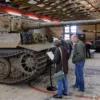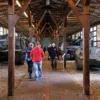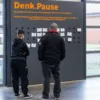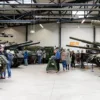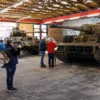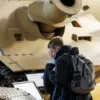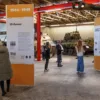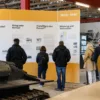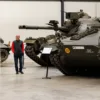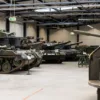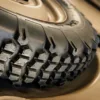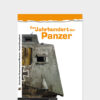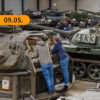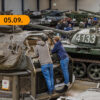Exhibition
History(s) of steel – discover our exhibition.
Photographs of a Soviet barracks in Mahlwinkel by a Bundeswehr soldier, 1992
Inv. no.: DPM 9.2439 – DPM 9.2459
In the reunified Germany of 1990, there were still hundreds of thousands of foreign soldiers from the former occupying powers. The Two-Plus-Four Treaty stipulated that Soviet troops had to withdraw from the territory of the former GDR.
Permanent exhibition
and exhibits
More than technology – history(ies) made of steel.
The permanent exhibition, which opens in February 2023, offers a comprehensive narrative on over 50 panels that takes a critical and multi-perspective look at tanks. From the history of technology and tactics, to economic and social history, cultural and political history and from the beginning of the Panzerwaffe to the future of the tank, there are a wide variety of perspectives on tanks.
The exhibition now also integrates the theme of “Suffering, Killing, Dying” with photos of violence as a clearly visible cross-cutting theme in the exhibition.The exhibition of the German Tank Museum Munster comprises over 150 large objects and extends over 5 halls on over 10,000 square meters. The permanent exhibition extends over the first two halls, while the display depot can be freely explored in three further halls.
Large exhibits
List of large exhibits
This list shows the exhibits of the new permanent exhibition, presumably until the renovation is completed with the expected federal funding. This exhibition was opened in February 2023. From this point onwards, Halls 3-5 will serve as a display depot.
As exhibits are frequently removed for maintenance or repairs, for example, this list does not always reflect the actual status of the exhibition.
Exhibition book
The century of tanks
The book is available in our museum store on site.
Under the following link you will find a table with further information and literature references to our exhibition book “The Century of Tanks”.
Further informationon site
Site plan
Our site at a glance.
Whether exhibition halls, special areas or service facilities – our site plan will help you find your way around the museum grounds quickly and easily. Plan your tour and discover the history step by step.
Download site plan0 Introduction
1 1900-1933: World War and the Weimar Republic
2 1933-1941: Blitzkrieg and crime
3 1941-1944: War of extermination
4 1944-1949: End of the war
5 1949-1962: Cold War
6 1962-1990: Arms race or détente
7 1990-today: Bundeswehr in action
8 Futures of the tank
R Reflection areas
Virtual tour
This link will take you on a virtual tour of the Tank Museum.
This tour shows the exhibition before the new permanent exhibition is published. This makes it possible to take a look at the exhibits without large text panels. Further content from the exhibition will gradually be added to the tour.
From February 1, 2023, you will also be able to discover the many new contents of the newly created permanent exhibition with all your senses in the museum.
Many thanks to Linsenspektrum for their support and for making the tour possible.
to the virtual tourFAQs
Frequently asked questions about the museum and the exhibition
“But if you want peace, talk about war”
Walter Benjamin
Who was Walter Benjamin?
Walter Benjamin (1892-1940) was a translator and philosopher. As an assimilated Jew and communist, Benjamin fled Germany into exile in 1933. He killed himself there in 1940 at the age of 48 for fear of being extradited to the National Socialists. His works were little recognized during his lifetime. Since the 1960s, however, Benjamin has been regarded as one of the great thinkers of the 20th century.
Where does the quote come from?
The chosen quote comes from the 1926 essay “Friedensware”, in which Benjamin criticizes the fact that pacifism is of no use if it does not have the strength to deal openly and critically with the very war it rejects. Such uncritical pacifism is little more than a moral fig leaf and often useful lip service for those who actually consider war to be a justifiable means.
“Si vis pacem para bellum”
“If you want peace, prepare for war.” This Roman saying aims to enforce peace through the threat and use of military force. Benjamin’s quote aims to develop this approach further after the experience of the uncontrolled, industrial mass slaughter of the First World War.
Under the auspices of total war, arming for war would not bring peace, but only suffering and destruction. But if war had become unfeasible, humanity would have to avoid it altogether in future. And in order to achieve this, the horrors of modern war must be shown, discussed and remembered in an unembellished and blatant manner – in order to remove any temptation to wage war. A small change in the choice of words, a big change in the message.
What does the quote mean for the Tank Museum?
The museum actively upholds the values of a free and democratic basic order, which also includes the rejection of war as far as possible. Our contribution to this is to encourage visitors to engage with war in an informed, critical and independent way. Our portrayal of war must therefore be honest and unsparing. It can only serve peace if nothing is trivialized and nothing is glossed over. (see FAQ: Why are violent images shown in the exhibition?)
Content warning: This text deals with the depiction of violence in the Tank Museum.
Goals:
The tanks in this museum are embedded in historical contexts. The lighter sides of the subject, such as comradeship and technical achievements, are shown as well as the darker sides of the subject, such as suffering and exercising violence. Because tanks are “machines of violence”. We want to show the various forms of violence in the exhibition in order to highlight the consequences of war and violence. Around 20 pictures in the exhibition show the effects of violence or the threat of violence, often in or through the tank.
Cover:
Viewing the violent images is voluntary. The images are covered and identified by a clear symbol. The image can only be viewed when the cover is lifted. This allows the viewer to decide for themselves whether they want to view the image.
In particular, people with high protection needs, such as children, veterans or people suffering from post-traumatic stress disorder (PTSD), should be protected.
Children:
As a parent, guardian or teacher, you decide whether to show the children and young people these images of violence. Please talk to the children and young people about the problem and supervise them during the exhibition tour.
Teachers should contact our museum educator if they have any questions and would like to view the pictures before their visit.
Limited accessibility:
To prevent small children from reaching the cover, the violent images must be hung as high as possible. However, with every centimeter that the pictures are positioned higher, it becomes increasingly difficult and eventually impossible for smaller people and especially wheelchair users to reach the cover. We have not yet found a solution to this dilemma that we can implement financially. If you are interested, adults can view the illustrations in a folder at the cash desk after their visit.
“Stahl auf der Heide” (SadH) is a series of events organized by the Tank Museum in which selected tanks were shown in action once a year. The event was suspended in 2020 as we expected the major renovation work to begin soon. As SadH means a lot of work in advance and therefore a long lead time, we didn’t want the start of construction to cancel a SadH that was already being planned. Instead, “Stahl auf der Heide” was to be held again in a new, bigger and better form after the major renovation.
In the meantime, it has become clear that it is completely unclear when construction will begin and that it may be another few years away. As we will have reached an important milestone in the development of the museum with the new permanent exhibition in February 2023, we are examining the relaunch of SadH.
The earliest possible date would be summer 2027 due to the necessary preparation time. We will provide information about possible new dates on our website and our social media channels.
We mark the diversity of genders in the exhibition texts. Instead of “soldiers”, for example, we now write “female soldiers” if there was a recognizable proportion of female soldiers in the respective period.
In addition to this bisexuality, the colon should also include all queer people (LGBTQIA+). How high their share was in the respective periods has not yet been sufficiently researched.
The “Elements of War” was an exhibition area opened in 2012 that displayed many small objects. The hand weapons, medals, uniforms and toys were categorized here historically and culturally. The area was popular with many visitors and was viewed with great interest. It had to be closed in 2018 and is still sorely missed today.
Why were the “elements of war” closed?
In September 2018, the Military Counterintelligence Service (MAD) routinely inspected the area and surprisingly came to the conclusion that the protection of the handguns in the display cases was no longer sufficient. Unfortunately, it was not possible to circumvent this regulation, for example through stock protection, and objections were rejected. This area therefore had to be closed to visitors with immediate effect. A conversion of the display cases, which would have met the requirements of the MAD, is currently not financially feasible. The museum also does not have any demilitarized handguns that could be exhibited with fewer security requirements.
Why is the MAD allowed to decide that?
The MAD is allowed to make this decision on the basis of the licensing agreement. This regulates the joint sponsorship of the museum between the town of Munster and the Bundeswehr. According to the contract, the Bundeswehr is responsible, among other things, for “the security of the exhibits within the framework of the guidelines issued by the Federal Minister of Defense.” For this reason, the security of the “war weapons” exhibits is and must be reviewed at regular intervals and adjusted if necessary.
Why are small objects such as uniforms and medals not displayed elsewhere?
Unfortunately, it is not possible to exhibit the small objects that were in the “elements of war” elsewhere in the museum for conservation and security reasons. Air-conditioned and secure display cases are very expensive and cannot compensate for the high temperature differences in the unheated halls (see FAQ: “Why are no uniforms shown with the tanks?”). This brings us full circle to the promised federal funding for the conversion of the entire museum(see FAQ: “Why has the Tank Museum still not been converted?”). Only after the conversion can small objects finally be shown again, even among the large exhibits.
After years of concept development and persuasion, committee meetings, door-to-door and on-site discussions, debates, memoranda and dialogues, the time had finally come in November 2018: the German Tank Museum Munster was awarded a grant of 19.3 million euros from the federal budget (more precisely from “Section 14”). This funding is intended to ensure the preservation of the protected cultural assets and enable a modern exhibition in the tank museum.
The amount is extraordinary for a museum like ours. It underlines the fact that politicians recognize the special thematic significance of the museum and support the developments in the museum’s work in recent years as well as the plans for the future.
Unfortunately, the federal administration has not yet found a solution that would allow the funds to flow and construction to begin. The 19.3 million in funding approved by the Bundestag in 2018 for the modernization of the Tank Museum has not yet been called up, which is due to the unique civil-military structure of the museum.
However, in order to finally present some important history/stories about the tank in the museum, we opened a new permanent exhibition in February 2023. This already shows a fraction of what we would like to show in the new building, which is almost twice the size.
During a visit by politicians and the administration in summer 2022, concrete plans were considered to solve the problems surrounding the funding. The review is still pending. We hope for the best! Only then will we be able to present a concrete timetable for the new building.
Exhibition climate:
The current exhibition halls have no heating and are poorly insulated. Museum objects require an average temperature of between 18 and 22° C with a relative humidity of 45 to 55 percent to prevent damage. Climate measurements in the halls over the course of the year revealed fluctuations between -1° and 30° C, with humidity fluctuating between 29 and 99 percent.
What happens to the objects if the indoor climate is poor?
Due to the poor indoor climate, the dew point is already at 11° C in some cases: from this room temperature, condensation collects on the surface of the objects and display cases, causing mold and water stains. Uniforms, helmets and other items of equipment had to be removed from the exhibition due to mold infestation. The massive penetration of sunlight causes paper, textile and plastic objects to fade and become brittle. In addition, the temperature on the objects rises at certain points due to the sunlight: steel, rubber and wood become brittle and crack, original paint flakes off and is lost forever. Condensation penetrates the cracks and eats away at the metal from the inside. This also affects the tanks and other vehicles in the exhibition. This is to be prevented with the new construction of the museum (see FAQ “Why has the Tank Museum still not been rebuilt?”).
Mold infestation on a piece of NVA equipment
Why are the objects not displayed in air-conditioned showcases?
Air-conditioned showcases cannot compensate for these large temperature jumps. They are only suitable as support if exhibition rooms are already temperature-controlled. They are also very expensive to purchase, maintain and operate. A new construction of temperature-controlled halls is more economical, more sustainable and also protects the large objects.
Why are the small objects not being shown elsewhere? The area where the “Elements of War” exhibition was previously shown can no longer be used as an exhibition area (see FAQ Where is the “Elements of War” exhibition area?). Objects can be shown for a short period in the partially heated lobby of the museum. We therefore try to offer you changing special exhibitions at this location. On our website you can get an impression of the small objects in our collection in the “Object of the month” format and we also present small objects from the collection on our YouTube channel.
In the exhibition you will only find texts in German.
All exhibition texts in several languages (English, French, Spanish, Russian), spoken tours (German, English), a museum tour in sign language and offers for children and young people can be found in our media guide.
You can either borrow a device free of charge against a deposit or access the content on your own smartphone.
What was the military model exhibition?
For 20 years, there was a fixed item on the program at the Tank Museum: the military model exhibition. The two-day event had an excellent reputation in the model-making scene and also inspired other people for the subject.
New content, new permanent exhibition:
A lot has happened at the Tank Museum in the meantime. A new permanent exhibition has been developed and has been on display since February 2023. It realizes the ambition that the museum has developed over the last 10 years and which could only not be fully implemented due to the bureaucratic delay of the renovation: To embed the tanks in the halls in a historical context – and to do so in the lighter sides of the subject, such as camaraderie and technical achievements, as well as the darker sides of the subject, for example human suffering and crime. This content is now conveyed in over 50 texts and more than 150 photos and graphics. The tone of the exhibition and the museum has thus changed drastically for the first time in 40 years. (see FAQ: Why are violent images shown in the exhibition?)
Trade fairs and museums no longer go together:
For a long time, the permanent exhibition was purely technical: tanks stood next to tanks and the object texts provided information about the respective vehicle, but larger historical contexts were not presented. This was a shame from a museological point of view, but had the side effect that a cheerful and informal event such as the model exhibition could be hosted in the museum for two days.
In the new permanent exhibition, the two approaches no longer fit together: The new exhibition contains a lot of information about the dark side of 100 years of armor – in words and pictures. We have therefore decided that the museum is no longer the right place for the military model exhibition. We regret the loss of a traditional annual event and wish the team and exhibitors all the best and have offered our help in finding a new venue.
Specific questions about your visit? Here you will find more answers about your visit to the Tank Museum.
events
For big & small!
Immerse yourself in the fascinating history of military technology and experience our events about historic vehicles, exciting lectures and lively presentations. Whether you’re a technology fan, history buff or a family outing – there’s something for everyone here!


